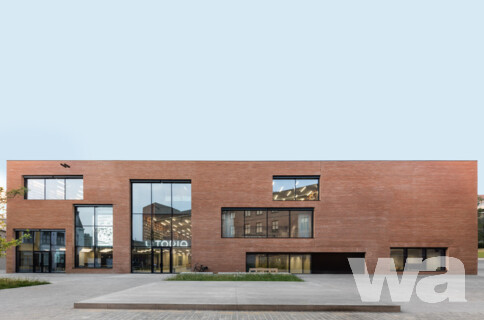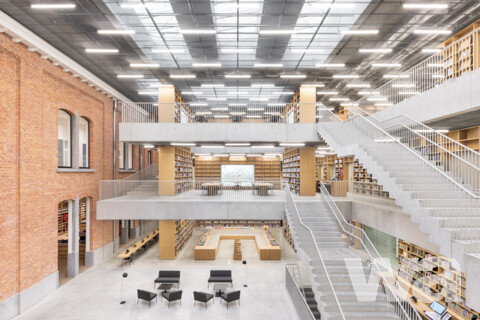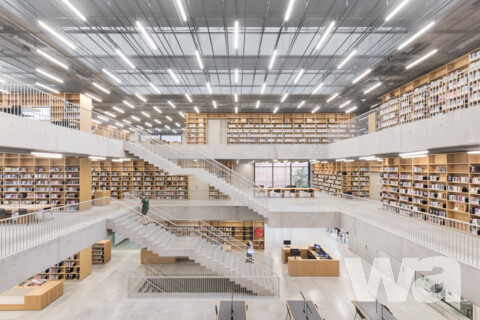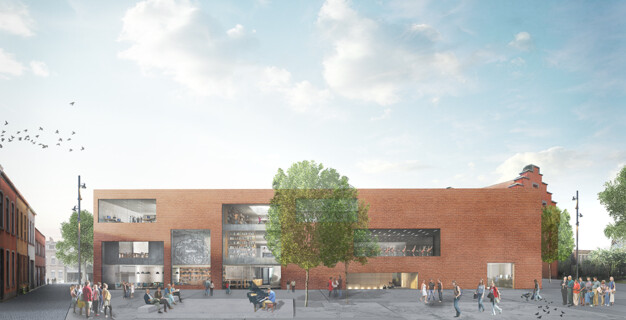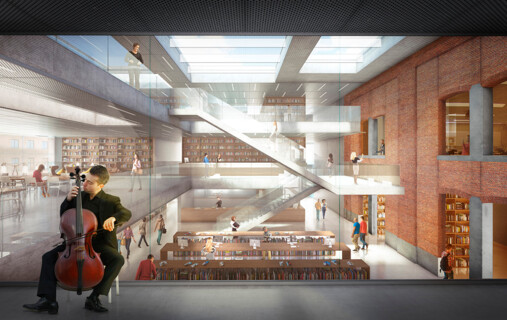- wa-ID
- wa-2020307
- Tag der Veröffentlichung
- 11.07.2016
- Aktualisiert am
- 27.06.2018
- Verfahrensart
- Einladungswettbewerb
- Auslober
- Stadt Aalst
- Preisgerichtssitzung
- 30.06.2016
- Fertigstellung
- 05/2018
Vielen Dank für Ihre Nachricht
Gewinner
Kaan Architecten, Rotterdam
project team: Bas Barendse, Tjerk de Boer, Sebastiaan Buitenhuis, Sebastian van Damme, Raluca Firicel, Narine Gyulkhasyan, Joost Harteveld, Martina Margini, Giuseppe Mazzaglia, Kevin Park
Wettbewerbsaufgabe
The new complex for the municipal library and the Academy for Performing Arts in the heart of the Flemish city of Aalst will have a lively, urban character. It may sound contradictory, but precisely because the plan of the design by KAAN Architecten is functional, the result is a certain spatial freedom that enriches the experience of the building.
The complex, situated on the corner of Oude Graanmarkt and Esplanadestraat, will be completed in 2018 – a century on from the end of World War I.
The so-called Pupillenschool (once a school for military children), with its grand presence and eventful history, will be integrated as a ‘cornerstone’ to anchor the new complex in the surrounding urban fabric and in the hearts of the people of Aalst. The new part will be two to three times bigger than the existing building. The loadbearing structure of the building’s shell will fully (and economically) coincide with the open layout of the interior. There will be closed spaces created where required for certain activities.
The irregular street pattern of the historic centre of Aalst was a source of inspiration and forms the foundation for the new complex. At various points the streets converge erratically, leaving small open spaces – tiny public squares that dot the old city centre. By inserting a rectangular edifice loosely against the back and part of the side of the Pupillenschool, Aalst has gained two more of such small public squares: one serving as the entrance area for the complex and the other as terrace for the reading café.
Not long ago it was claimed that libraries would become obsolete in the digital age. Indeed, everyone can electronically access any book or document. Yet, contrary to the predictions, it appears that in many places all over the world libraries have blossomed rather than declined. A place for book-borrowing has evolved into a place for public encounters, where people can read, study and linger, spending time somewhere other than at home, school or work. Aalst’s city councillors have understood this development, hence their brief: “A library for Aalst that will become an open and accessible place, a home for information, knowledge, culture and leisure opportunities.”
Other, no less important stipulations included that the design by KAAN would be an impetus for the fulfilment of a vibrant city centre and a place where all of the different communities within Aalst can meet each other.
Apart from the library, the building will house the Academy for Performing Arts with its music, dance, theatre and singing. The combination of a library and arts academy may not at first seem very logical. The performing arts involve movement and noise, while reading is a static and quiet activity. The blending of the two, however, is also infectious and gives greater impact to the idea of a meeting place. KAAN Architecten believes the combination sets them a challenge to design a building that lets each complement the other in an ideal way. Aalst dances, plays and reads – this could be a motto that speaks to the imagination.
With the exception of the existing part that will be incorporated, the complex is free of architectural ornamentation.
But vibrancy is its companion. Windows and skylights that appear to be randomly placed let light in during the day and radiate light at night, which corresponds with the illumination concept devised for the city centre. The windows offer unobstructed views over the sightlines through the building, the pictures of historic prints of Aalst appended to several walls, the shelves of books and the rehearsal spaces for the various performing arts. The complex is not ornamented, but is itself an ornament for the city.
The library will display the printing press of the renowned Humanist Dirk Martens, printer and publisher, who distributed Thomas More’s Utopia in Aalst at the beginning of the 16th century. An image of the fanciful utopia will be represented on an expanse of wall directly behind one of the large windows. The interior will be dominated by wood cladding. Complementing the spaciousness and sightlines traversing the complex, the wooden shelving, floors and wainscotting will achieve a sense of intimacy.
The new complex for the municipal library and the Academy for Performing Arts in the heart of the Flemish city of Aalst will have a lively, urban character. It may sound contradictory, but precisely because the plan of the design by KAAN Architecten is functional, the result is a certain spatial freedom that enriches the experience of the building.
The complex, situated on the corner of Oude Graanmarkt and Esplanadestraat, will be completed in 2018 – a century on from the end of World War I.
The so-called Pupillenschool (once a school for military children), with its grand presence and eventful history, will be integrated as a ‘cornerstone’ to anchor the new complex in the surrounding urban fabric and in the hearts of the people of Aalst. The new part will be two to three times bigger than the existing building. The loadbearing structure of the building’s shell will fully (and economically) coincide with the open layout of the interior. There will be closed spaces created where required for certain activities.
The irregular street pattern of the historic centre of Aalst was a source of inspiration and forms the foundation for the new complex. At various points the streets converge erratically, leaving small open spaces – tiny public squares that dot the old city centre. By inserting a rectangular edifice loosely against the back and part of the side of the Pupillenschool, Aalst has gained two more of such small public squares: one serving as the entrance area for the complex and the other as terrace for the reading café.
Not long ago it was claimed that libraries would become obsolete in the digital age. Indeed, everyone can electronically access any book or document. Yet, contrary to the predictions, it appears that in many places all over the world libraries have blossomed rather than declined. A place for book-borrowing has evolved into a place for public encounters, where people can read, study and linger, spending time somewhere other than at home, school or work. Aalst’s city councillors have understood this development, hence their brief: “A library for Aalst that will become an open and accessible place, a home for information, knowledge, culture and leisure opportunities.”
Other, no less important stipulations included that the design by KAAN would be an impetus for the fulfilment of a vibrant city centre and a place where all of the different communities within Aalst can meet each other.
Apart from the library, the building will house the Academy for Performing Arts with its music, dance, theatre and singing. The combination of a library and arts academy may not at first seem very logical. The performing arts involve movement and noise, while reading is a static and quiet activity. The blending of the two, however, is also infectious and gives greater impact to the idea of a meeting place. KAAN Architecten believes the combination sets them a challenge to design a building that lets each complement the other in an ideal way. Aalst dances, plays and reads – this could be a motto that speaks to the imagination.
With the exception of the existing part that will be incorporated, the complex is free of architectural ornamentation.
But vibrancy is its companion. Windows and skylights that appear to be randomly placed let light in during the day and radiate light at night, which corresponds with the illumination concept devised for the city centre. The windows offer unobstructed views over the sightlines through the building, the pictures of historic prints of Aalst appended to several walls, the shelves of books and the rehearsal spaces for the various performing arts. The complex is not ornamented, but is itself an ornament for the city.
The library will display the printing press of the renowned Humanist Dirk Martens, printer and publisher, who distributed Thomas More’s Utopia in Aalst at the beginning of the 16th century. An image of the fanciful utopia will be represented on an expanse of wall directly behind one of the large windows. The interior will be dominated by wood cladding. Complementing the spaciousness and sightlines traversing the complex, the wooden shelving, floors and wainscotting will achieve a sense of intimacy.
